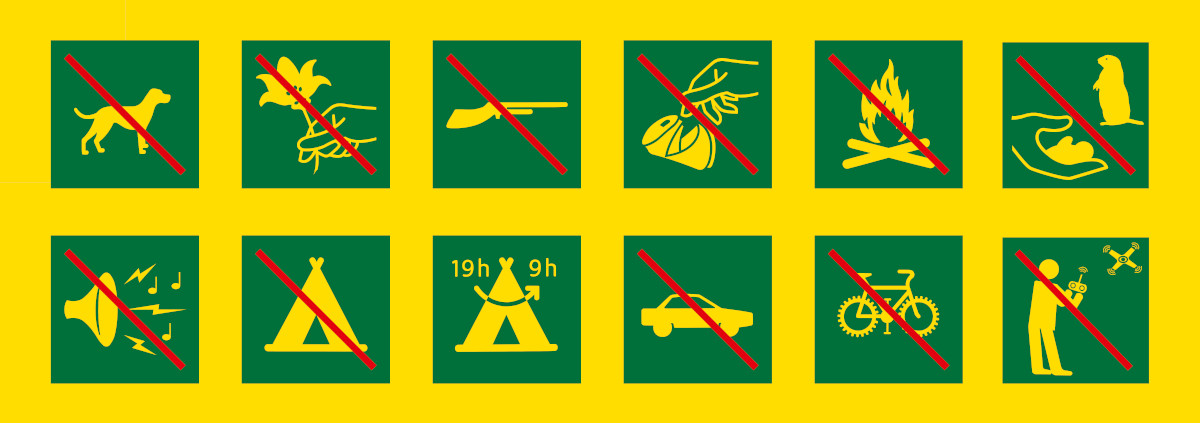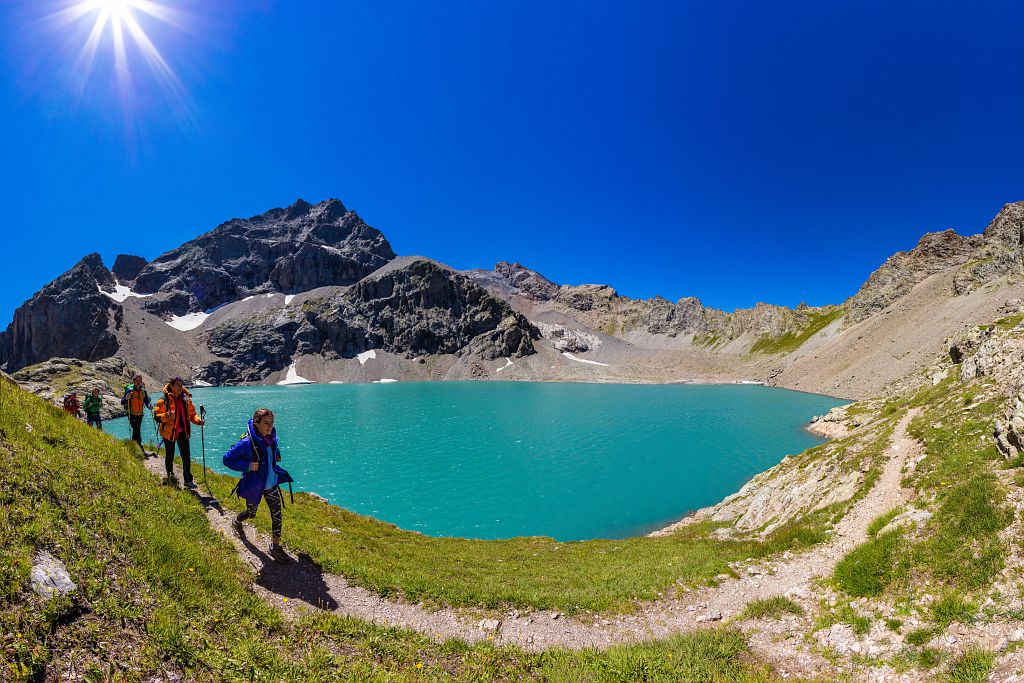
3.
33 points of interest
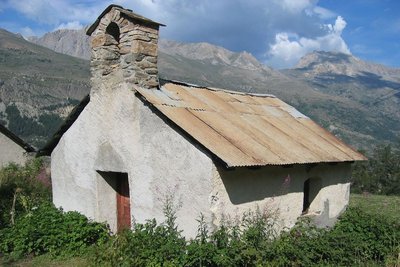
Chapelle Saint-Antoine du Charvet - © Florence Chalandon  History
HistoryCharvet Chapel
Near the arrival of the old Charvet button lift, dating from 1948 (still present, but disused since the end of the 2003/2004 season), is the Charvet chapel, which was built in 1755. Easy to access both in summer and winter from Le Monêtier, it provides hikers with a wonderful panorama over the southern Guisane valley.
It is quite unusual for a chapel in the region to be dedicated to Saint Anthony of Padua rather than to Saint Anthony the Great. Was there a shift in patronage over time? The fact the saints had the same name led to the particular qualities of each one being mixed up.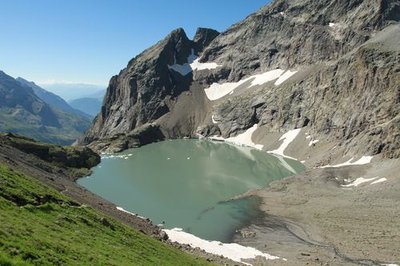
Lac de l'Eychauda - Marie-Geneviève Nicolas - PNE  Lake
LakeEychauda Lake
Principally supplied with water by the Séguret-Foran glacial torrent, Eychauda lake is glacial: cold with water full of ground rock particles, lacking oxygen in winter, it is not conducive of life even if a few trout, originally from trout farms set up in the 1950s and 1960s survive there... Nestling in the deep basin in the shade of the high mountain walls, de, it stays frozen for a long time. Icebergs sometimes remain until August. Its principal torrent does not stay on the surface but gets lost in a system of holes and scree.
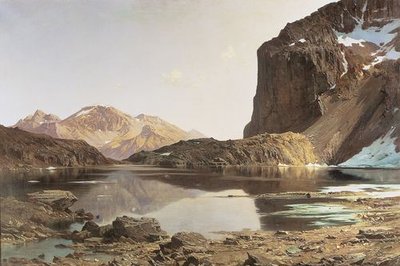
Le Lac de l'Eychauda, Laurent Guétal - © Musée de Grenoble  History
HistoryLe Lac de l'Eychauda, Laurent Guétal
In the second half of the nineteenth century, Laurent Guétal was one of the most prominent painters of Dauphiné landscapes. In 1886 he painted a picture entitled Le Lac de l'Eychauda, from a study he had completed in situ a few years earlier at 2,514 metres above sea level. Painted in three weeks for the Salon, the work was favourably received and earned the artist two medals. While the bottom of the painting is presented as a succession of horizontal bands, at the top the sky is set against the dark mass of the mountain. The attention paid to detail helps to reinforce the scale of this site, magnified by light.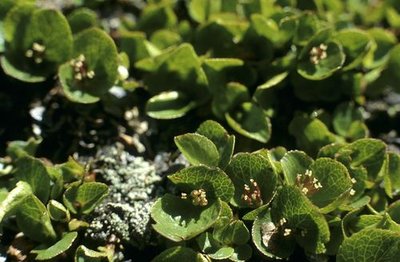
Saule herbacé - Marie-Geneviève Nicolas - PNE  Flora
FloraDwarf Willow
Around the lake the grass is short: it is an alpine lawn. In the hollows, the snow remains for a long time at this altitude and the plants have little time to flower and reproduce. Only certain plants that are perfectly adapted can survive the « snow patches », scientific term to describe this particular environment. In this way the Dwarf Willow, cousin to the Weeping Willows, is a woody plant covering the ground hardly lifting up except by its small leaves and catkins.
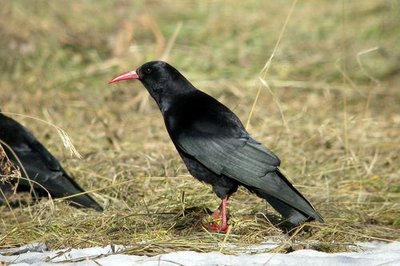
Crave à bec rouge - Damien Combrisson - PNE  Fauna
FaunaRed Billed Chough
Recognizable far away by its raucous cry, the Red Billed Chough (and red feet!) sometimes gets mixed up in flocks of Alpine Choughs. But they are more timid. They dominate the high mountains less than the Alpine Choughs and sometimes inhabit sea cliffs.
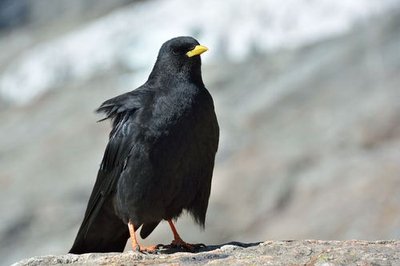
Chocard à bec jaune - Mireille Coulon - PNE  Fauna
FaunaYellow Billed Chough
If you picnic beside a lake, you will certainly be visited by these black birds with yellow beaks and red feet: The Choughs. Wrongly called choucas (which live at a lower altitude), sociable birds that live in groups, they are great acrobats and very opportunistic. Their diet is varied, from vegetable peelings to cheese rinds!
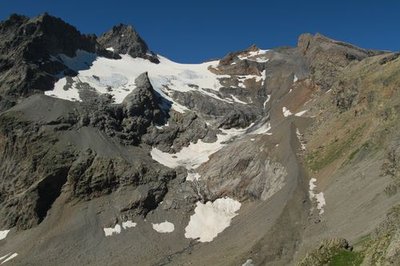
Le glacier de Séguret Foran - Marie-Geneviève Nicolas - PNE  Geology and geography
Geology and geographyGlacial terrain
With a long flat bottomed valley, its cross cliff retaining the lake, the recent moraines behind these and at the bottom, the Séguret-Foran lake, the terrain is typically one modelled by the glacier. Large quaternary glaciations, small age for ice and for the current glacier have left, as they moved away, the characteristic marks of their passage.
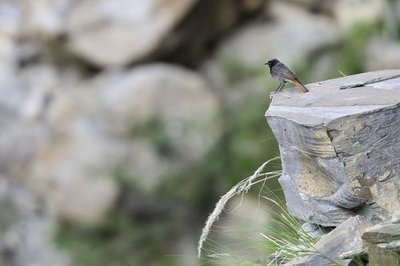
Rougequeue noir mâle - Mireille Coulon - PNE  Fauna
FaunaBlack Redstart
Even if it is well known in an urban environment, the Black Redstart is originally a mountain bird which has been able to adapt to other environments, as long as there are walls for it to build its nest! It is very present in the Chambran valley, arriving early in Spring, leaving late in Autumn. This Black Redstart is often semi migratory and is happy to join the vallies or the South of France in winter.
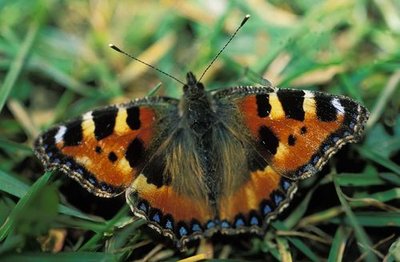
Petite-Tortue ou Vanesse de l'ortie - Jean-Pierre Nicollet - PNE  Fauna
FaunaSmall Tortoiseshell Butterfly
You will see plenty of nettles around the pastoral cabin! It is a plant living on soils full of nitrogen, which comes from the urine and the excrement of the moutons spending the night here. The small tortoiseshell caterpillars love to eat their leaves; the name in French refers to the caterpillar not the butterfly! The butterfly, also called the small tortoiseshell, can be from March onwards because it is rare for adult butterflies to hibernate.
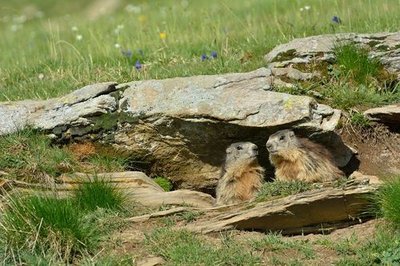
Marmottes dans leur terrier - Mireille Coulon - PNE  Fauna
FaunaMarmot
If you do not leave too late, you are likely to be able to see the marmots. They like the grass where they can dig their burrows. Stay discreet, do not try to approach them, you will disturb them. Don’t expect to see them in the hottest part of the day: it is much too hot to go out and there are too many people around!
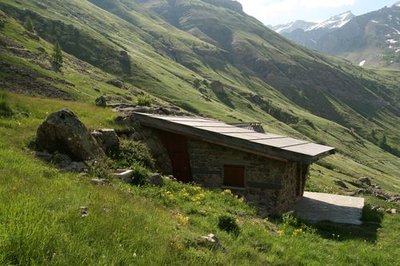
Cabane pastorale du vallon de l'Eychauda - Marie-Geneviève Nicolas - PNE  Architecture
ArchitectureEychauda Pastoral Cabin
This cabin shelters the shepherd from June to September. In order to not be carried away by the avalanches, it has been built under the shelter of the big boulder and it has a pitched roof that extends along the slope of the mountain. Another cabin situated above the Chambon valley makes it possible for the flock to exploit the supply of grass over the weeks.
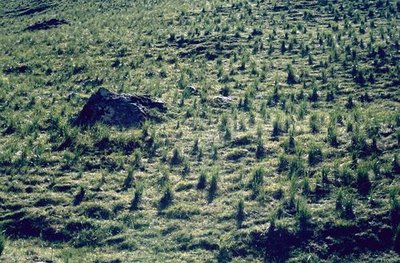
Fétuque paniculée - Manuel Meester  Flora
FloraEast Alpine Violet Fescue
Right up to the cabin, you can distinguish in the surrounding prairies big tufts of tough grass, the East Alpine Violet Fescue. This poaceae (a grass) is in competition with all the other plants and takes up a lot of space. Formerly, mowing limited its development and encouraging other meadow plants for foraging. At the moment, this plant must be grazed early in the season when the leaves have not yet hardened after this the animals refuse them.

Traquet motteux - Damien Combrisson - PNE  Fauna
FaunaNorthern Wheatear
Perched on a rock, a bird is alarmed it cries ouit ouit or tchac tchac. You can recognize it straight away thanks to its white rump and its tail with a black backward T: a Northern Wheatear. It is a migratory bird that needs open spaces with big rocks under which the female can build its nest.

Bruant jaune - Damien Combrisson - PNE  Fauna
FaunaYellow Hammer
In the bottom of the valley, at the beginning of the summer, you will certainly hear, coming from the summit of a bush or a tree, the song composed of several notes in the same tone followed by a final higher or lower note... With binoculars, you can distinguish a bird with yellow and white feathering, the well named Yellow Hammer. It is a male, the female is more discreet as much in song as in its feathers! Listen well: Beethoven must have been inspired by this song when composing the first notes of his 5th symphony!
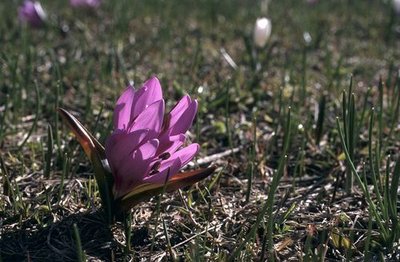
Le bulbocode printanier ou colchique de printemps - Marie-Geneviève Nicolas - PNE  Flora
FloraSpring meadow saffron
May in Chambran valley: the snow has only just melted, when it appears, almost hiding all the grass yellowed by the winter, a pink carpet of Spring Meadow Saffron. The Spring Meadow Saffron, is a plant close to the Colchicaceae (but flowers in Spring as its name indicates!) it can be distinguished from the crocus, with whom it grows, by its pink open flower ; the crocus flower is mauve or white and closed.. The first belongs to the lily family and the second to the iris family.
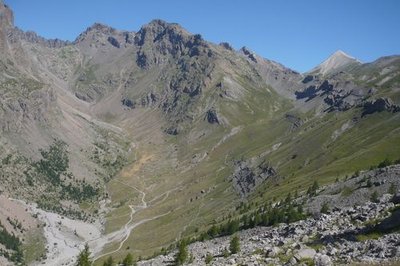
Les deux versants du vallon de Chambran - Marie-Geneviève Nicolas  Geology and geography
Geology and geographyThe front of the nappes
The two slopes of the Chambran valley are very different: the right bank, minerals are very present. There are granites and gneiss making up the crystalline base of the Ecrins massif. On the left bank, the prairies are sandstone and chalky. These are part of the glacial thrust sheet: they are ancient sediments deposited mostly to the East, in the Alpine ocean, then carried here by compression at the time of the formation of the Alps.

Troupeau de brebis - Mireille Coulon - PNE  Pastoralism
PastoralismEvolution of pastoralism
In the valley, the ruins of numerous piles of stones resulting from the removal of stones in the hay meadows are witness to another age. Most of these old prairies are now grazed by sheep. Pastoralism has evolved: no more local flocks so less hay, the valley is now occupied by a large flock from the Haute-Provence Alps.
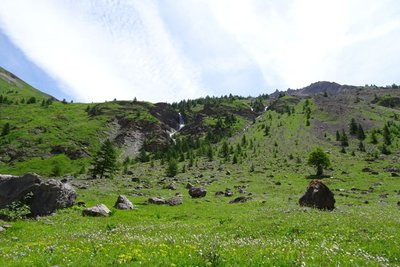
Parc à moutons - Office de tourisme Pays des Écrins  Pastoralism
PastoralismThe realm of sheep
Together with its entire catchment area, the Chambran valley constitutes an enormous alpine pasture. Sheep belonging to several different owners are gathered here for the summer grazing season. Many of them come from the department of Alpes-de-Haute-Provence. The landscape (sheep paths, old hay meadows), vegetation, built structures (old dairy, pastoral cabins)... everything has been marked by centuries of animal husbandry.
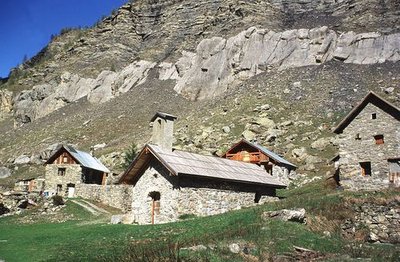
Le hameau de Chambran - Marie-Geneviève Nicolas - PNE  History
HistoryChambran Hamlet
At an altitude of 1700 meters, this hamlet is inhabited in summer, at the beginning of the summer pasture. The old dairy has been spruced up to become a snack bar. It’s pretty little chapel dedicated to Saint Jean is very simple and bare.
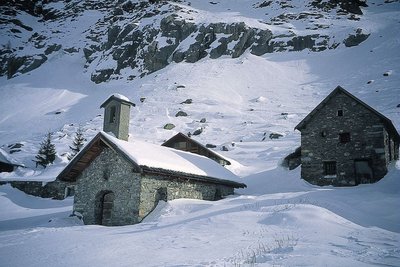
Les chalets de Chambran sous la neige - Marie-Genevève Nicolas - PNE  Vernacular heritage
Vernacular heritageChambran chalets
Remnants of a way of life that has disappeared, the Chambran chalets were once a high-altitude village where flocks stayed during the summer months. Today this is a welcome stop along the GR54 and the starting point for hikes towards Lake Eychauda.

Chocard à bec jaune en vol - Mireille Coulon - Parc national des Écrins  Fauna
FaunaChoughs and red-billed choughs
A flight of black birds twists and turns before descending on the alpine meadows. The choughs are seeking out meagre takings, preferably small invertebrates. Great acrobats and sociable birds, they stand out with their yellow beaks and red legs. Sometimes a few red-billed choughs mingle with them. These are more timid and have a red beak and red legs. Both species nest on cliffs.
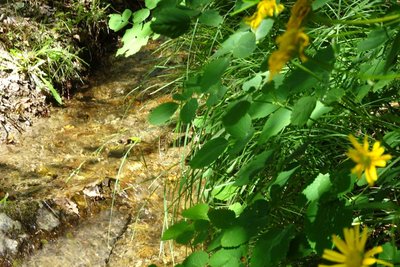
Le Canal du Béal Neuf - Office de tourisme Pays des Écrins  Water
WaterASA of Béal Neuf
The ASA (authorised water user association) of Béal Neuf is the owner of the canal. The association manages, maintains and develops the Béal Neuf canal which carries water to the entire network of irrigation canals.
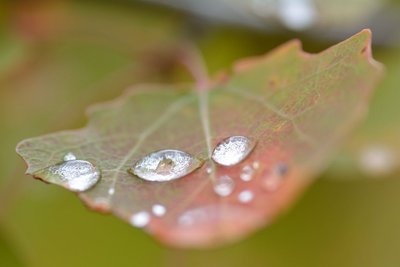
Gouttes d'eau sur une feuille de tremble - Mireille Coulon - Parc national des Écrins  Flora
FloraThe aspen
The path runs through a small aspen wood. This tree with a smooth, greenish trunk and rounded, crenelated leaves takes on magnificent autumn colours. The stem, or petiole, of aspen leaves is flat and twisted, so it can be caught by the slightest breeze making the foliage «quake» hence its common name, the quaking aspen. It grows in places where the soil is quite damp.
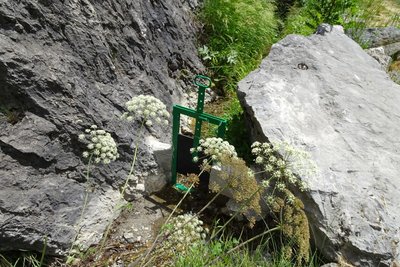
Martelière qui assure la distribution de l'eau - Office de tourisme Pays des Écrins  Water
WaterWater in the mountains
Since the Middle Ages, canals have been dug to carry water to the crops. The water is diverted by the canals: through the action of gravity, the water flows down the mountain sides. Use of the water is regulated and for any draw-off, the volume is measured.
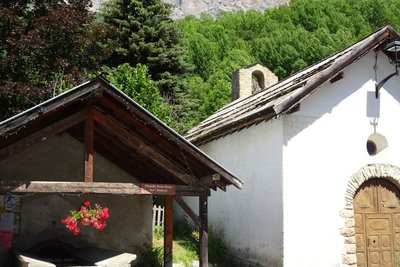
La chapelle aau Fangeas - Office de tourisme Pays des Écrins  Vernacular heritage
Vernacular heritageThe minor heritage of Pelvoux
Every hamlet has its own chapel. In the territory of Pelvoux, Les Claux has the chapel of Sainte-Barbe with a restored sun dial dating from 1792. The seventeenth-century chapel of Saint-Pancrace is in Le Poët. In Le Sarret, you can admire the chapel of Saint-Joseph and the chapel of Notre-Dame des Sept Douleurs stands in Le Fangeas. Every hamlet has its own communal oven and water fountains as well. Finally, the church of Saint-Antoine is located in the hamlet of Saint-Antoine. It has a sun dial dating from 1810.
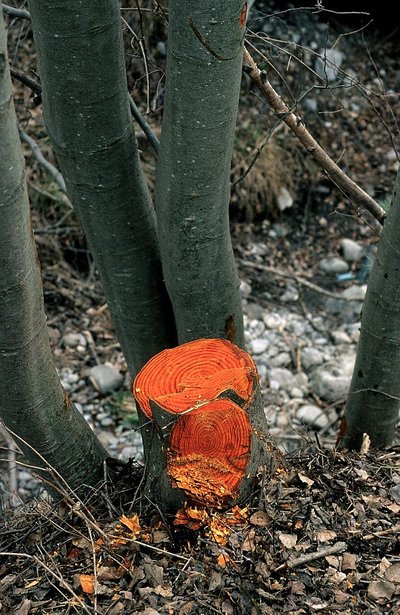
L'aulne blanc - Nicollet Bernard - Parc national des Ecrins  Flora
FloraThe grey alder
In the valleys of the Alps and the Jura, the grey alder often grows in place of the black alder, present in many parts of France. Like its cousin, it grows on riversides and plays an important role in stabilising the banks. If it is cut down, its wood is bright orange in colour. But why cut it down?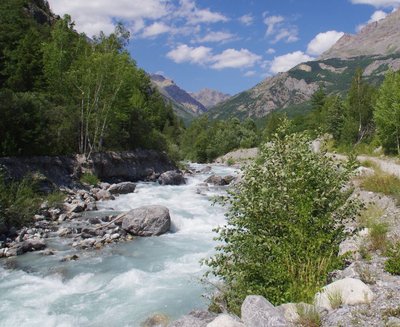
Le Gyr - Office de tourisme du Pays des Écrins  Water
WaterThe Gyr
Humans are decidedly bizarre animals: they build, knock down and start again. To protect the new infrastructures of Pelvoux, the Gyr was dammed. But, not able to flow as it did before, it deepened its bed, thus placing the foundations in danger of damage. And so works were carried out to widen its bed, allowing it to flow more naturally. This is also more favourable for biodiversity, as well as protecting the developed urban areas.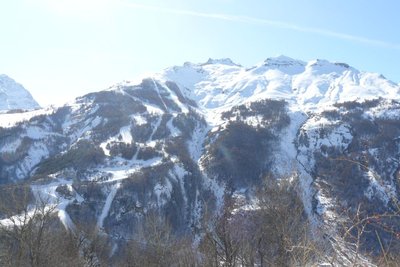
Vue sur la station de Pelvoux-Vallouise - Pelvoux Office de tourisme du Pays des Écrins  Vernacular heritage
Vernacular heritageThe ski resort of Pelvoux-Vallouise
The route first leads through the small ski resort of Pelvoux-Vallouise, built in 1982. Very family-focused, in winter it's the ideal place for young children to learn to ski, with small lifts lower down, while their big brothers and sisters can ski higher up.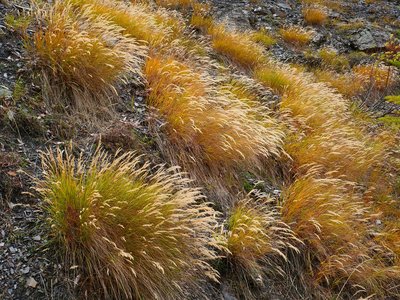
Le calamagrostide argentée - Nicolas Marie-Geneviève - Parc national des Écrins  Flora
FloraSilver spike grass
A grass grows in large clumps on the embankment: silver spike grass. It is adapted to stony, dry and sunny ground. Its inflorescences reflecting silvery-gold glints create a beautiful effect, but they are particularly noticeable in the late summer, when it forms large shimmering bouquets in the evening sunlight.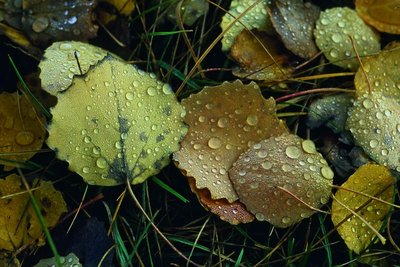
Des feuilles de tremble - Bernard Nicollet - Parc national des Écrins  Flora
FloraThe aspen
On the right, a stand of aspens with smooth, greenish trunks and rounded, crenelated leaves take on magnificent colours in autumn. The stem, or petiole, of aspen leaves is flat and twisted, so it can be caught by the slightest breeze making the foliage «quake» hence its common name, the quaking aspen.
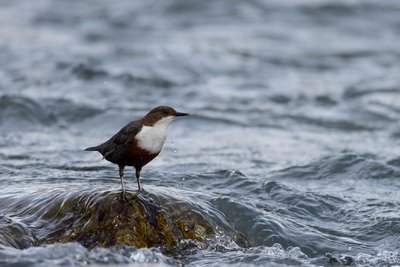
Cincle plongeur - Mireille Coulon - Parc national des Ecrins  Fauna
FaunaThe white-throated dipper
Perched on a rock in the middle of the river, a squat bird with a short tail, brown with a large white bib, bobs up and down with his tail in the air. He then dives and only reappears a few moments later. This is how this bird hunts, diving into the water and then walking against the current along the river bed searching for aquatic insect larvae, small crustaceans or small fish, lifting pebbles with its beak to dislodge them.
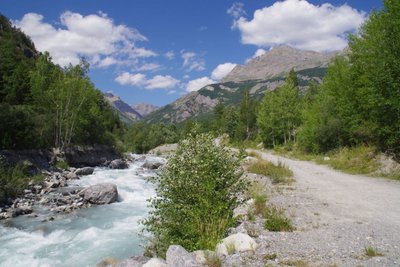
Forêt au bord du Gyr - Office de tourisme Pays des Écrins  Flora
FloraForest on the water's edge
This small wood is a fragment of the riparian forest: natural forest growing adjacent to a body of water. Reduced everywhere due to urbanisation, this type of forest is made up of alder, willow and oak, and also poplar, birch and aspen, among others
La truite fario - Parc national des Écrins  Fauna
FaunaThe trout
But what's the angler angling for? The brown trout of course! This is the mountain fish par excellence, with a streamlined body to withstand the current more efficiently and light brown skin speckled with black and red. It lives in cold, oxygen-rich waters.
Altimetric profile
Sensitive areas
Black grouse - winter
- Impacted practices:
- , Land
- Sensitivity periods:
- JanFebMarAprDec
- Contact:
- PN Ecrins BERGEON Jean-Pierre jean-pierre.bergeon@ecrins-parcnational.fr QUELLIER Hélène helene.quellier@ecrins-parcnational.fr Membre de l OGM ogm.vds@gmail.com ogm.amblard@gmail.com
Recommandations
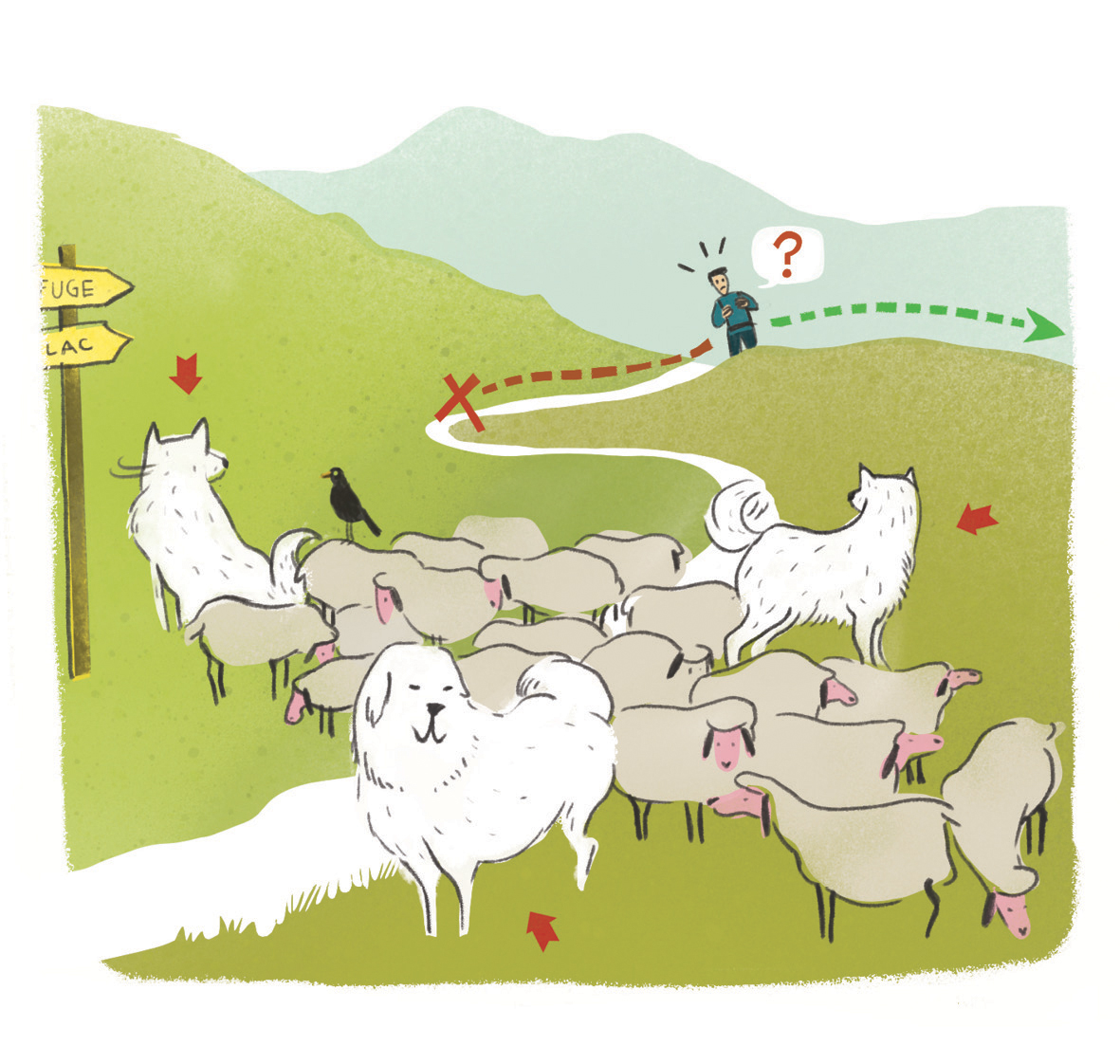 In mountain pastures, protection dogs are there to protect the herds from predators (wolves, etc.).
In mountain pastures, protection dogs are there to protect the herds from predators (wolves, etc.).
When I hike I adapt my behavior by going around the herd and pausing for the dog to identify me.
Find out more about the actions to adopt with the article "Protection dogs: a context and actions to adopt".
Tell us about your meeting by answering this survey.
Information desks
Maison du Parc du Briançonnais
Place Médecin-Général Blanchard, 05100 Briançon
Located at the foot of the medieval town fortified by Vauban, declared World Heritage by UNESCO in 2008, the Maison du Parc Briançon is a welcoming place of information exchange. Three floors of exhibition to discover : the natural and cultural heritage, the museum of the history of skiing in Briançon. Documentation, maps, guidebooks, books and products of the Park. Guided tours for groups by reservation. Free admission.
Vallouise Park house
, 05290 Vallouise
Information, documentation, models, exhibitions, screenings, product sales and works of the Park. Guided tours for school, reservation required. The new Park House opened in Vallouise since June 1, and offers visitors an interactive permanent exhibition inviting to explore the area and its heritage. A temporary exhibition space will allow a renewed offer. Finally, the device is completed by an audiovisual room to organize screenings and conferences Free admission. All animations of the Park are free unless otherwise stated.
Source

Report a problem or an error
If you have found an error on this page or if you have noticed any problems during your hike, please report them to us here:

